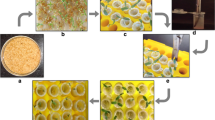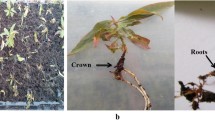Abstract
Ralstonia solanacearum causes a bacterial wilt of ginger (Zingiber officinale) that hampers ginger production. Because pathogenicity tests using rhizomes are laborious and time-consuming, here we developed a new test using ginger plants that were aseptically regenerated in vitro from shoot tips using 6-benzyl adenine and 1-naphthalene acid (NAA) in Murashige–Skoog (MS) agar. The regenerated plants were then cultured in MS broth with NAA to evaluate pathogenicity after the roots were dipped into a bacterial solution. The wild-type strain (MAFF 211479) caused wilt symptoms such as leaf yellowing within 15 days after inoculation (dpi), and plants had died by 28 dpi. MAFF 301069, an avirulent strain of ginger, did not cause any symptoms. Because method was suitable for assessing virulence of R. solanacearum, we then used to test the pathogenicity of MAFF 211479 mutants that we constructed and were defective in the type III secretion system. None of the mutants were pathogenic in the regenerated ginger plants or in eggplant. The mutant cells proliferated less efficiently than the wild type in the inoculated ginger plants. We thus conclude that aseptically regenerated ginger plants can be used to elucidate the infection mechanism of R. solanacearum in ginger.






Similar content being viewed by others
References
Al-Taha HA, Al-Mayah AA, Abd Al-Behadili WA (2020) Efficient in vitro regeneration of Zingiber officinale Rosc. var. White through shoot tips culture. Plant Arch 20:434–437
Boucher CA, van Gijsegem F, Barberis PA, Arlat M, Zischek C (1987) Pseudomonas solanacearum genes controlling both pathogenicity on tomato and hypersensitivity on tobacco are clustered. J Bacteriol 169:5626–5632
Cunnac S, Occhialini A, Barberis P, Boucher C, Genin S (2004) Inventory and functional analysis of the large hrp regulon in Ralstonia solanacearum: Identification of novel effector proteins translocated to plant host cells through the type III secretion system. Mol Microbiol 53:115–128
Deng W, Marshall NC, Rowland JL, McCoy JM, Worrall LJ, Santos AS, Strynadka NCJ, Finlay BB (2017) Assembly, structure, function and regulation of type III secretion systems. Nat Rev Microbiol 15:323–337
Dennis JJ, Zylstra GJ (1998) Plasposons: Modular self-cloning minitransposon derivatives for rapid genetic analysis of gram-negative bacterial genomes. Appl Environ Microbiol 64:2710–2715
Genin S, Denny TP (2012) Pathogenomics of the Ralstonia solanacearum species complex. Annu Rev Phytopathol 50:67–89
Goodin MM, Zaitlin D, Naidu RA, Lommel SA (2008) Nicotiana benthamiana: Its history and future as a model for plant–pathogen interactions. Mol Plant-Microbe Interact 21:1015–1026
Horita M, Yano K, Tsuchiya K (2004) PCR-based specific detection of Ralstonia solanacearum race 4 strains. J Gen Plant Pathol 70:278–283
Iiyama K, Imamura M, Inoue T, Kyaw HWW, Yano K, Horita M, Tsuchiya K, Furuya N (2021a) Pathogenicity evaluation of Ralstonia pseudosolanacearum race 4 on ginger by leaf-clipping inoculation. J Gen Plant Pathol 87:269–272
Iiyama K, Kodama S, Kusakabe H, Sakai Y, Horita M, Yano K, Kyaw HWW, Tsuchiya K, Furuya N (2021b) Complete genome sequences of Ralstonia solanacearum strains isolated from Zingiberaceae plants in Japan. Microbiol Resour Announc 10:e01303-e1320
Iiyama K, Michishita R, Arima H, Kyaw HWW, Yano K, Horita M, Tsuchiya K, Furuya N (2022) Possible invasion pathway of Ralstonia pseudosolanacearum race 4 in ginger plant. J Gen Plant Pathol 88:246–250
Ishii M, Aragaki M (1963) Ginger wilt caused by Pseudomonas solanacearum E F Smith. Plant Dis Rep 47:710–713
Kanda A, Yasukohchi M, Ohnishi K, Kiba A, Okuno T, Hikichi Y (2003) Ectopic expression of Ralstonia solanacearum effector protein PopA early in invasion results in loss of virulence. Mol Plant-Microbe Interact 16:447–455
Kumar A, Prameela TP, Suseelabhai R, Siljo A, Anandaraj M, Vinatzer BA (2014) Host specificity and genetic diversity of race 4 strains of Ralstonia solanacearum. Plant Pathol 63:1138–1148
Lei N, Chen L, Kiba A, Hikichi Y, Zhang Y, Ohnishi K (2020) Super-multiple deletion analysis of type III effectors in Ralstonia solanacearum OE1-1 for full virulence toward host plants. Front Microbiol 11:1683
Liu Y, Kanda A, Yano K, Kiba A, Hikichi Y, Aino M, Kawaguchi A, Mizoguchi S, Nakaho K, Shiomi H, Takikawa Y, Ohnishi K (2009) Molecular typing of Japanese strains of Ralstonia solanacearum in relation to the ability to induce a hypersensitive reaction in tobacco. J Gen Plant Pathol 75:369–380
Paret ML, de Silva AS, Criley RA, Alvarez AM (2008) Ralstonia solanacearum race 4: risk assessment for edible ginger and floricultural ginger industries in Hawaii. HortTechnology 18:90–96
Peeters N, Carrère S, Anisimova M, Plener L, Cazalé A-C, Genin S (2013) Repertoire, unified nomenclature and evolution of the Type III effector gene set in the Ralstonia solanacearum species complex. BMC Genom 14:859
Portnoi G, Chng LA, Karimi-Tabesh L, Koren G, Tan MP, Einarson A (2003) Prospective comparative study of the safety and effectiveness of ginger for the treatment of nausea and vomiting in pregnancy. Am J Obstet Gynecol 189:1374–1377
Prasath D, Karthika R, Habeeba NT, Suraby EJ, Rosana OB, Shaji A, Eapen SJ, Deshpande U, Anandaraj M (2014) Comparison of the transcriptomes of ginger (Zingiber officinale Rosc.) and mango ginger (Curcuma amada Roxb.) in response to the bacterial wilt infection. PLoS ONE 9:e99731
Prior P, Fegan M (2005) Recent developments in the phylogeny and classification of Ralstonia solanacearum. Acta Hortic 695:127–136
Salvi ND, George L, Eapen S (2002) Micropropagation and field evaluation of micropropagated plants of turmeric. Plant Cell Tissue Organ Cult 68:143–151
Schäfer A, Tauch A, Jäger W, Kalinowski J, Thierbach G, Pühler A (1994) Small mobilizable multi-purpose cloning vectors derived from the Escherichia coli plasmids pK18 and pK19: selection of defined deletions in the chromosome of Corynebacterium glutamicum. Gene 145:69–73
Shaik J, Jaffar Shaik C, Kanth RG (2018) In vitro propagation of Zingiber officinale through rhizome and effect of plant growth regulators. J Pharmacogn Phytochem 7:2012–2014
Suraby EJ, Sruthi KB, Antony G (2022) Genome-wide identification of type III effectors and other virulence factors in Ralstonia pseudosolanacearum causing bacterial wilt in ginger (Zingiber officinale). Mol Genet and Genom 297:1371–1388
van Gijsegem F, Vasse J, Camus JC, Marenda M, Boucher C (2000) Ralstonia solanacearum produces hrp-dependent pili that are required for PopA secretion but not for attachment of bacteria to plant cells. Mol Microbiol 36:249–226
Vasse J, Genin S, Frey P, Boucher C, Brito B (2000) The hrpB and hrpG regulatory genes of Ralstonia solanacearum are required for different stages of the tomato root infection process. Mol Plant-Microbe Interact 13:259–267
Waki T, Horita M, Kurose D, Mulya K, Tsuchiya K (2013) Genetic diversity of Zingiberaceae plant isolates of Ralstonia solanacearum in the Asia-Pacific region. Jpn Agric Res Q 47:283–294
Yoshimochi T, Zhang Y, Kiba A, Hikichi Y, Ohnishi K (2009) Expression of hrpG and activation of response regulator HrpG are controlled by distinct signal cascades in Ralstonia solanacearum. J Gen Plant Pathol 75:196–204
Zhang Y, Chen L, Yoshimochi T, Kiba A, Hikichi Y, Ohnishi K (2013) Functional analysis of Ralstonia solanacearum PrhG regulating the hrp regulon in host plants. Microbiology 159:1695–1704
Acknowledgements
We thank Yuzhu Cao and Rana Lokendra for caring for plants.
Funding
This work was supported by JSPS KAKENHI Grant-in-Aid for Scientific Research (C) Grant Number 20K06054 (to KO) and by a Cabinet Office grant in aid, the Advanced Next-Generation Greenhouse Horticulture by IoP (Internet of Plants), Japan.
Author information
Authors and Affiliations
Contributions
All authors contributed to study conception and design. Material preparation, data collection and analysis were performed by MH, AK, MT, and KO. The first draft of the manuscript was written by MH, YH, and KO, and all authors commented on previous and read and approved the final manuscript.
Corresponding author
Ethics declarations
Conflict of interest
The authors declare that they have no conflicts of interest.
Ethical approval
This study does not include any experiments with human participants or animals performed by any of the authors.
Additional information
Publisher's Note
Springer Nature remains neutral with regard to jurisdictional claims in published maps and institutional affiliations.
Supplementary Information
Below is the link to the electronic supplementary material.
Rights and permissions
Springer Nature or its licensor (e.g. a society or other partner) holds exclusive rights to this article under a publishing agreement with the author(s) or other rightsholder(s); author self-archiving of the accepted manuscript version of this article is solely governed by the terms of such publishing agreement and applicable law.
About this article
Cite this article
Hasan, M., Kiba, A., Hikichi, Y. et al. Method for aseptically regenerating ginger plants and studying infection by Ralstonia solanacearum using hrp mutants. J Gen Plant Pathol 89, 185–191 (2023). https://doi.org/10.1007/s10327-023-01121-9
Received:
Accepted:
Published:
Issue Date:
DOI: https://doi.org/10.1007/s10327-023-01121-9




